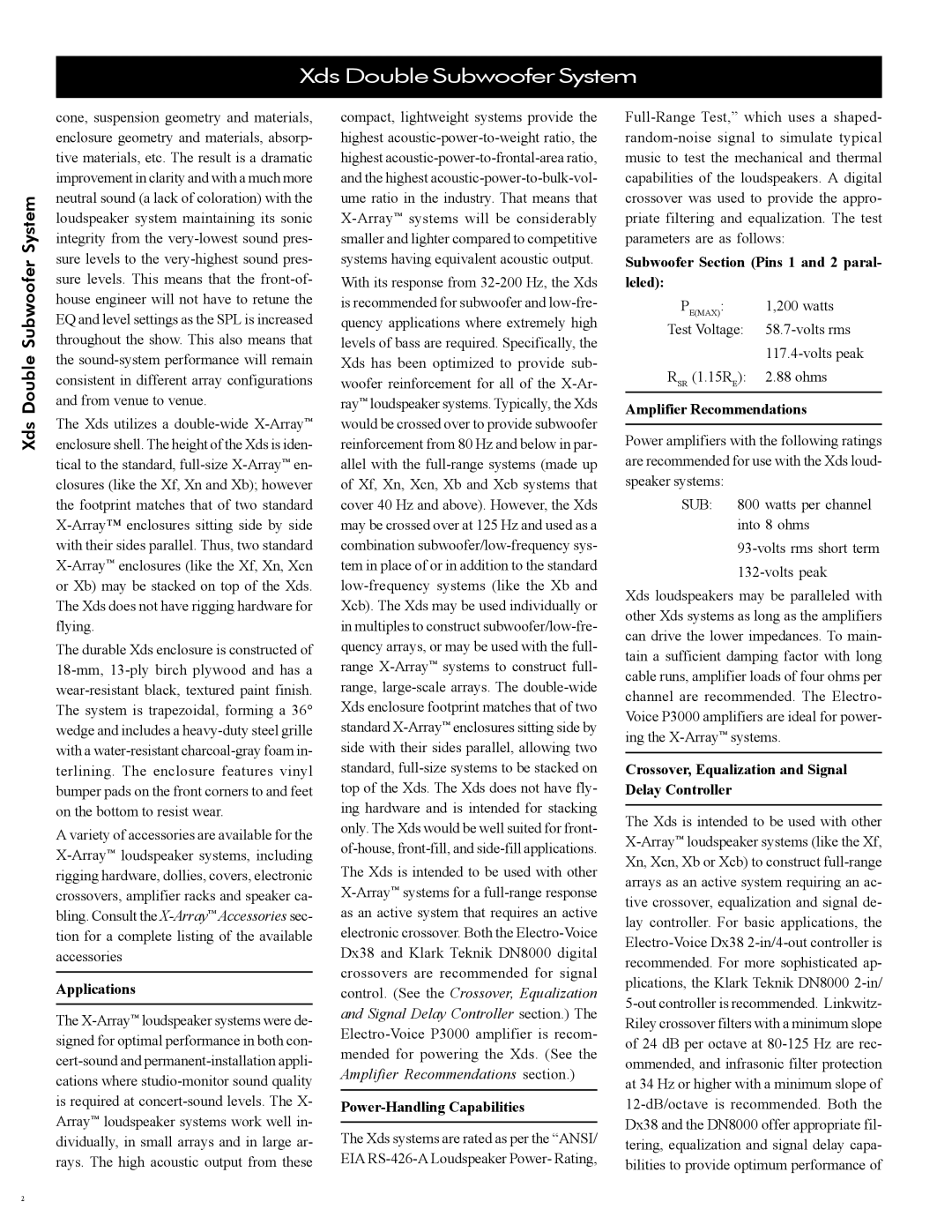Xds Double Subwoofer System
cone, suspension geometry and materials, enclosure geometry and materials, absorp- tive materials, etc. The result is a dramatic improvement in clarity and with a much more neutral sound (a lack of coloration) with the loudspeaker system maintaining its sonic integrity from the very-lowest sound pres- sure levels to the very-highest sound pres- sure levels. This means that the front-of- house engineer will not have to retune the EQ and level settings as the SPL is increased throughout the show. This also means that the sound-system performance will remain consistent in different array configurations and from venue to venue.
The Xds utilizes a double-wide X-Array™enclosure shell. The height of the Xds is iden- tical to the standard, full-size X-Array™en- closures (like the Xf, Xn and Xb); however the footprint matches that of two standard X-Array™ enclosures sitting side by side with their sides parallel. Thus, two standard X-Array™enclosures (like the Xf, Xn, Xcn or Xb) may be stacked on top of the Xds. The Xds does not have rigging hardware for flying.
The durable Xds enclosure is constructed of 18-mm, 13-ply birch plywood and has a wear-resistant black, textured paint finish. The system is trapezoidal, forming a 36° wedge and includes a heavy-duty steel grille with a water-resistant charcoal-gray foam in- terlining. The enclosure features vinyl bumper pads on the front corners to and feet on the bottom to resist wear.
A variety of accessories are available for the X-Array™loudspeaker systems, including rigging hardware, dollies, covers, electronic crossovers, amplifier racks and speaker ca- bling. Consult the X-Array™Accessories sec- tion for a complete listing of the available accessories
Applications
The X-Array™loudspeaker systems were de- signed for optimal performance in both con- cert-sound and permanent-installation appli- cations where studio-monitor sound quality is required at concert-sound levels. The X- Array™ loudspeaker systems work well in- dividually, in small arrays and in large ar- rays. The high acoustic output from these
compact, lightweight systems provide the highest acoustic-power-to-weight ratio, the highest acoustic-power-to-frontal-area ratio, and the highest acoustic-power-to-bulk-vol- ume ratio in the industry. That means that X-Array™systems will be considerably smaller and lighter compared to competitive systems having equivalent acoustic output. With its response from 32-200 Hz, the Xds is recommended for subwoofer and low-fre- quency applications where extremely high levels of bass are required. Specifically, the Xds has been optimized to provide sub- woofer reinforcement for all of the X-Ar- ray™ loudspeaker systems. Typically, the Xds would be crossed over to provide subwoofer reinforcement from 80 Hz and below in par- allel with the full-range systems (made up of Xf, Xn, Xcn, Xb and Xcb systems that cover 40 Hz and above). However, the Xds may be crossed over at 125 Hz and used as a combination subwoofer/low-frequency sys- tem in place of or in addition to the standard low-frequency systems (like the Xb and Xcb). The Xds may be used individually or in multiples to construct subwoofer/low-fre- quency arrays, or may be used with the full- range X-Array™systems to construct full- range, large-scale arrays. The double-wide Xds enclosure footprint matches that of two standard X-Array™enclosures sitting side by side with their sides parallel, allowing two standard, full-size systems to be stacked on top of the Xds. The Xds does not have fly- ing hardware and is intended for stacking only. The Xds would be well suited for front- of-house, front-fill, and side-fill applications. The Xds is intended to be used with other X-Array™systems for a full-range response as an active system that requires an active electronic crossover. Both the Electro-Voice Dx38 and Klark Teknik DN8000 digital crossovers are recommended for signal control. (See the Crossover, Equalization and Signal Delay Controller section.) The Electro-Voice P3000 amplifier is recom- mended for powering the Xds. (See the Amplifier Recommendations section.)
Power-Handling Capabilities
The Xds systems are rated as per the “ANSI/ EIA RS-426-A Loudspeaker Power- Rating,
Full-Range Test,” which uses a shaped- random-noise signal to simulate typical music to test the mechanical and thermal capabilities of the loudspeakers. A digital crossover was used to provide the appro- priate filtering and equalization. The test parameters are as follows:
Subwoofer Section (Pins 1 and 2 paral- leled):
PE(MAX): | 1,200 watts |
Test Voltage: | 58.7-volts rms |
| 117.4-volts peak |
RSR (1.15RE): | 2.88 ohms |
| |
Amplifier Recommendations
Power amplifiers with the following ratings are recommended for use with the Xds loud- speaker systems:
SUB: 800 watts per channel into 8 ohms
93-volts rms short term
132-volts peak
Xds loudspeakers may be paralleled with other Xds systems as long as the amplifiers can drive the lower impedances. To main- tain a sufficient damping factor with long cable runs, amplifier loads of four ohms per channel are recommended. The Electro- Voice P3000 amplifiers are ideal for power- ing the X-Array™systems.
Crossover, Equalization and Signal Delay Controller
The Xds is intended to be used with other X-Array™loudspeaker systems (like the Xf, Xn, Xcn, Xb or Xcb) to construct full-range arrays as an active system requiring an ac- tive crossover, equalization and signal de- lay controller. For basic applications, the Electro-Voice Dx38 2-in/4-out controller is recommended. For more sophisticated ap- plications, the Klark Teknik DN8000 2-in/ 5-out controller is recommended. Linkwitz- Riley crossover filters with a minimum slope of 24 dB per octave at 80-125 Hz are rec- ommended, and infrasonic filter protection at 34 Hz or higher with a minimum slope of 12-dB/octave is recommended. Both the Dx38 and the DN8000 offer appropriate fil- tering, equalization and signal delay capa- bilities to provide optimum performance of

